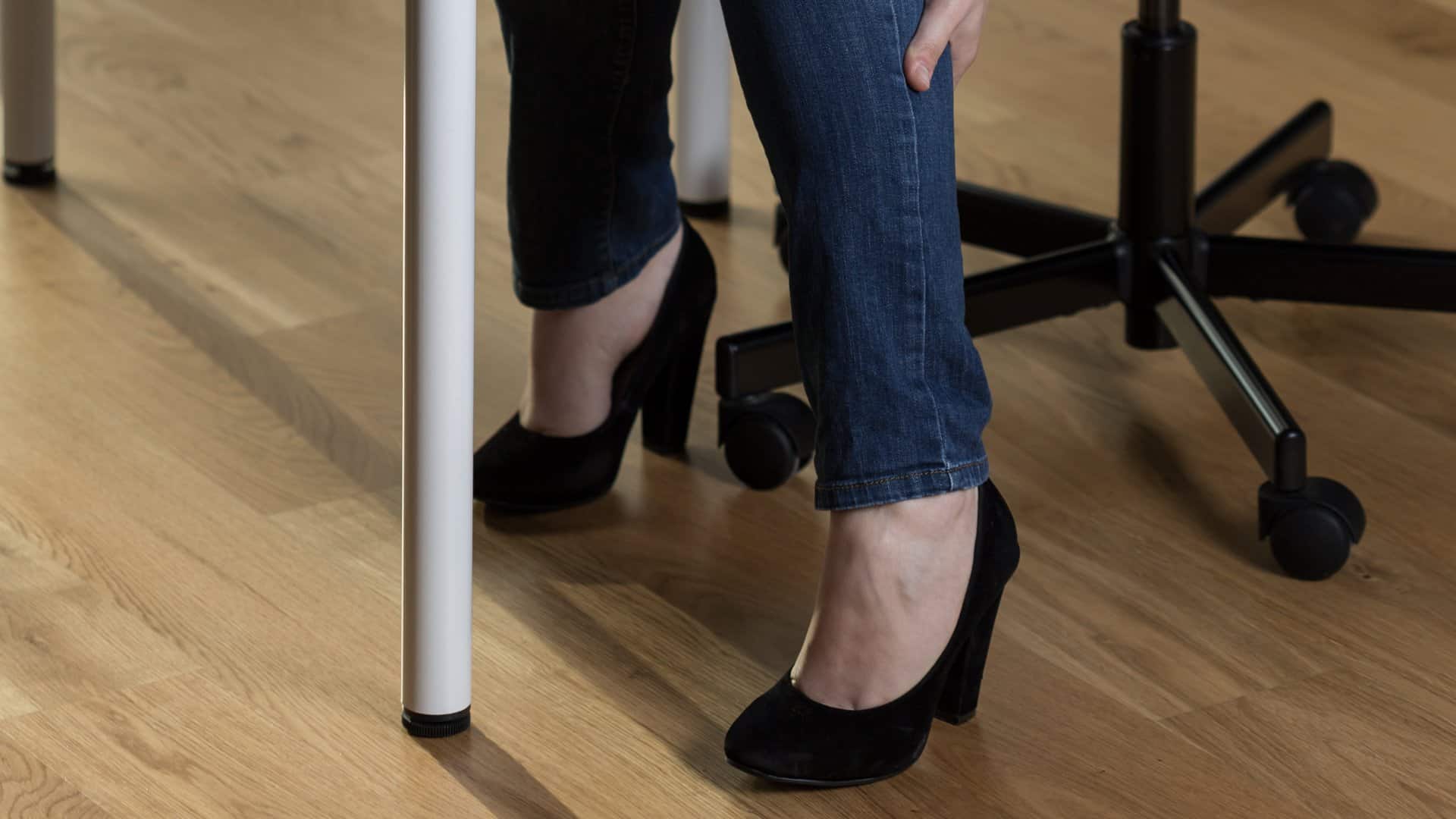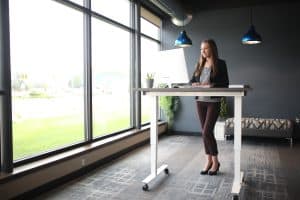If you’ve had a desk job for some time now, you may have already experienced the unpleasantness of having swollen feet. Maybe the aches and pains have become so unbearable that you cannot focus on your work, and you’re wondering what you can do to relieve the swelling and prevent it in the future.
In this article, we’ll cover tips and tricks about how you can reduce the swelling in your ankles from sitting in a chair for prolonged hours. We’ll also give some helpful advice about minimizing the chances of this happening again. So, let’s get to it.

Why Do Feet Swell From Too Much Sitting?
A common problem among people with jobs requiring them to sit for long hours is swollen feet. Swelling (or edema) happens due to fluids being trapped in the body’s tissues. The fluid build-up is caused by muscles not being active for prolonged hours. Edema can occur all around the body, however, it’s most present in hands, arms, legs, feet, and ankles. Fluid accumulation is common for people who sit in one position for longer than two hours, and it increases the more hours you spend sitting.
The edema that’s caused by prolonged periods of sitting is called dependent edema, and it generally isn’t painful. Even though you don’t feel any pain, having swollen feet can be uncomfortable. And it can even lead to more problems with your feet, such as varicose veins and blood clots.
Treating Swollen Feet Caused by Sitting at a Desk for Long Hours
If you’ve been having problems with swollen feet at work, we have a few ways that you can improve your condition.
Elevate Your Feet
Your feet become swollen when you sit for too long because gravity affects the movement of the fluids inside the body. So, fluids accumulate at the bottom if you keep your feet on the ground – hence swollen feet. So, the easiest thing you can do if you’re suffering from swollen feet is to keep them elevated as you work. You can do this by getting an additional stool under your desk that will help you keep the feet elevated, or even a footrest.
Elevating your feet once you get back from work is also a good idea. You can do this by lying down, placing a pillow under your legs, and keeping them above the heart level. Do this for about 20 minutes after you get back from work and repeat the procedure every 3 hours or as you need it throughout the day.
Exercise
The main reason for your feet swelling is the lack of movement in your feet. Therefore, doing some exercise will help you lower the swelling and help the fluid that has built up in your legs move to other parts of the body. Some of the exercises you may find helpful include:
- Knee lifts. Lift one leg and bend it towards your chest. Repeat the knee lift 20-30 times for each leg.
- Foot pumps. Lying down, point your toes and foot flat, then back up. Repeat; it’s like you are waving your foot up and down from the ankle.
- Ankle circles. Start at a neutral position and lift one foot, and rotate your ankle for 10 circles clockwise and 10 circles counterclockwise. Repeat it 5 to 10 times for each leg.
If you have the option to leave the office, it’s a great idea to break a long sitting cycle by taking a brisk walk. This improves your circulation, prevents your feet from swelling, and helps you take good care of your health.
Massage Your Feet
Another way to treat your swollen feet after a long day at work is to massage them. This reduces the swelling and helps you relax, and you can even massage during your break. You can try some of the following massages:
- Chop motion. Make a fist with your hand, extend the palm and gently massage the legs starting from the bottom of your feet and working your way up to your thighs.
- Squeeze and knead. Wrap your fingers around your ankles and start squeezing and massaging them. Move your way up to the thighs and then move to the other leg.
If you have a handheld massage aid, you can also use that. Just remember to work your way from the bottom of your feet to the thighs.
Soak Your Feet in Warm Water
Warm water promotes better circulation and allows your lymph nodes to loosen, which reduces the swelling in your feet. You can add warm water to your foot bath and include some Epsom salts, and you can then soak your feet for 15-20 minutes.
You can also use hydrotherapy activities that improve circulation and reduce swelling. You can try aquatic massages, underwater running, and even aquatic exercise.
Switch up Your Diet
Maintaining a healthy diet is good for your overall health and can help reduce the swelling of your feet.
For this, you need to make sure that you follow a diet that is rich in magnesium but low in salt. As you probably know, salt increases fluid retention and can cause swelling, so reducing your salt consumption will improve your health overall. On the other hand, you should ensure you eat plenty of seeds, nuts, legumes, and fiber-rich grains that are all rich in magnesium.
Consult Your Doctor
Swelling in your feet can also be a sign of other underlying conditions in your body, such as heart problems. So, it’s best to consult a specialist to get the proper medication for your situation.
How to Prevent Feet Swelling While Sitting at Desk?
Now that we’ve covered how you can reduce the swelling in your feet, it’s time to discuss the methods of preventing swollen feet in the first place.
Maintain Good Posture While Sitting
While maintaining good posture is paramount for the health of your spine and your body, maintaining good posture while sitting also prevents swelling. While sitting, you should always aim to lay your feet flat on the ground, as dangling feet may cause your feet to swell.
Use a Footrest
On top of maintaining a good posture, you would benefit from a footrest that will help support your feet and prevent swelling. You can adjust the footrest according to your height and the height of your desk.
Use Compression Socks
Another beneficial thing if you sit at a desk for long hours is purchasing compression socks that promote good circulation and prevent the fluid from building up in your legs. If it’s your first time using compression socks, opt for compression socks labeled 12 to 15 mm Hg. These compression socks are also recommended for preventing swelling and developing blood clots as you travel, as well as for preventing edema during pregnancy. And if those don’t work, you can always try out the socks with at least 35 mm Hg.
Avoid Sitting for Long Periods
If you want to prevent swelling in your feet, the easiest way is to move around often during your work day, thus minimizing the chances of getting swollen feet. It’s best to change your position every hour and do some minor stretching exercises before you start working again.
Avoid Uncomfortable Sitting Positions
This advice goes hand-in-hand with the previous one: avoiding sitting positions that make your feet uncomfortable and can cause swelling. Those positions include:
- Dangling feet. As we’ve mentioned above, leaving your feet dangling may cause poor circulation and swelling.
- Crossing legs. When your legs are crossed, the leg on the bottom is under more pressure and has less circulation than the one on top, so avoid this position as much as you can.
- Sitting with a tucked leg or legs. This position affects the circulation of your lower body the most. Keep your feet flat on the floor.
Wear Comfortable Clothes
All of these tips won’t work if you’re wearing tight clothes at work that limit your circulation and promote fluid retention. To avoid this problem, always opt for loose-fitting and comfortable clothes and shoes that allow the skin to breathe.
Stay Hydrated
The human body is a perfect and well-oiled machine; each process that happens depends on another process already happening. As we’ve mentioned, a build-up of sodium in the body can cause the fluid to build up, so naturally, hydration helps solve this problem. For optimal health and if you’d like to prevent swollen feet, it’s best to drink between 8 and 12 glasses of water daily. To ensure you’re adequately hydrated, keep a water bottle on your desk and sip some water throughout the day.
Use a Standing Desk
Keeping your body in one position for many hours is far from ideal. Therefore, it’s best to alternate between positions as you’re working and switch between sitting and standing positions. To do this, you’ll need an adjustable desk that can convert from a sitting to a standing desk and an office chair with an adjustable height. Most models will have the option to set your desk at different heights so you can choose the one that works the best for you. This way, you will not only prevent swelling but also benefit from burning off a few calories while standing and doing your work.
Use Desk Pedals
If a standing desk seems like a lot of work and is out of your budget, you can always opt for foot pedals instead. When placed under the desk, they enable you to keep your foot muscles active by pedaling as your work. This improves the blood circulation in the feet and helps keep the swelling at bay, and they’re a cheaper alternative to the adjustable desk. So, don’t knock them until you’ve tried them.
Final Thoughts on How to Prevent Feet Swelling While Sitting at Desk
While swollen feet seem like an inevitable part of working in an office, you’ve probably learned that there are a lot of things you can do to prevent this after reading this article.
You can keep the swelling at bay by wearing compression socks, taking regular breaks, and moving your body. But, you can also invest in a few minor improvements in your office, such as an adjustable desk and office chair that help you work standing or sitting, and even some pedals if you have a low budget.
Whichever solution you try, make sure that you do your best to keep yourself hydrated, maintain a balanced diet, and massage your feet when necessary to ensure that you never have to suffer from swollen feet again. Good luck!





